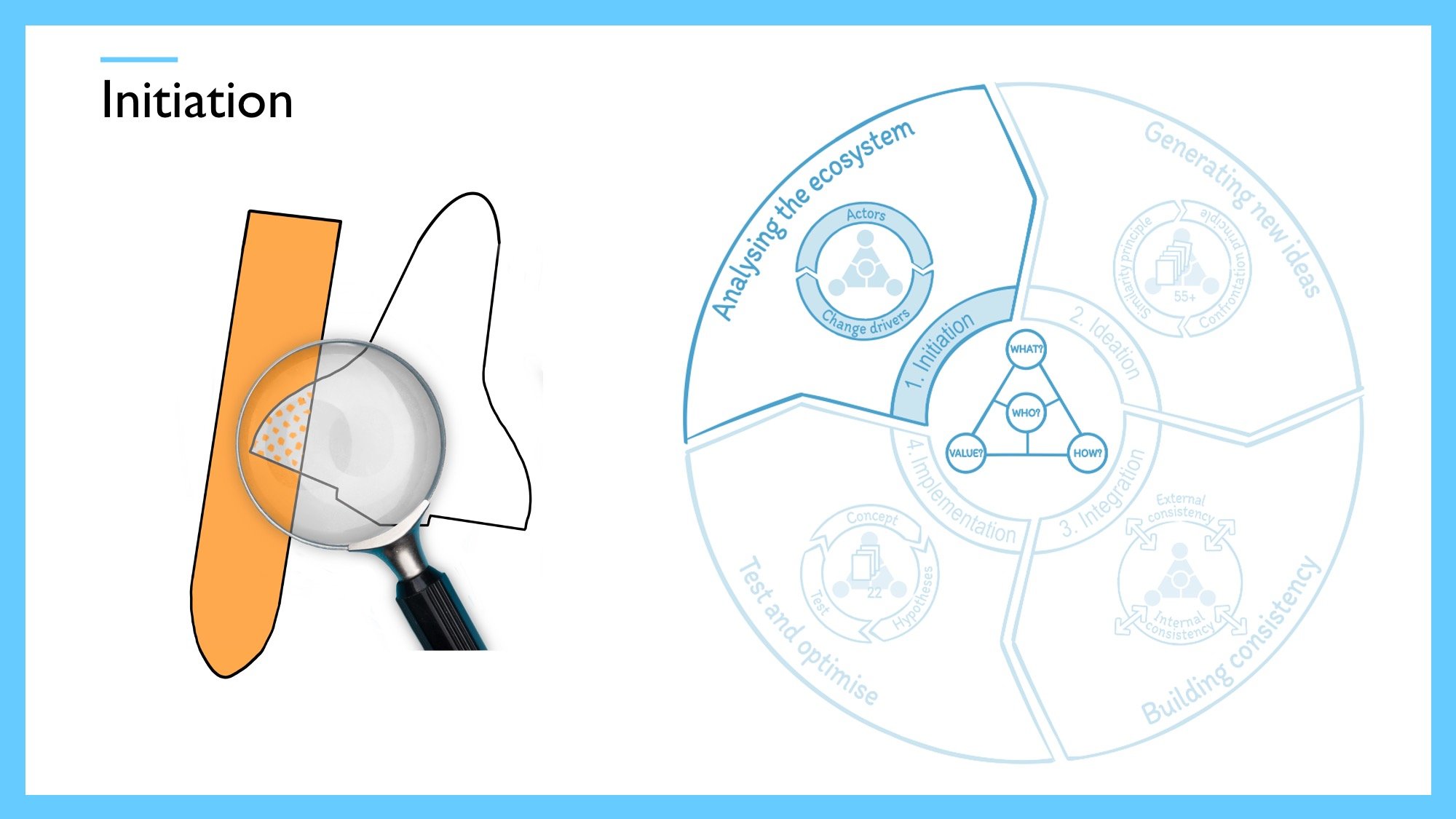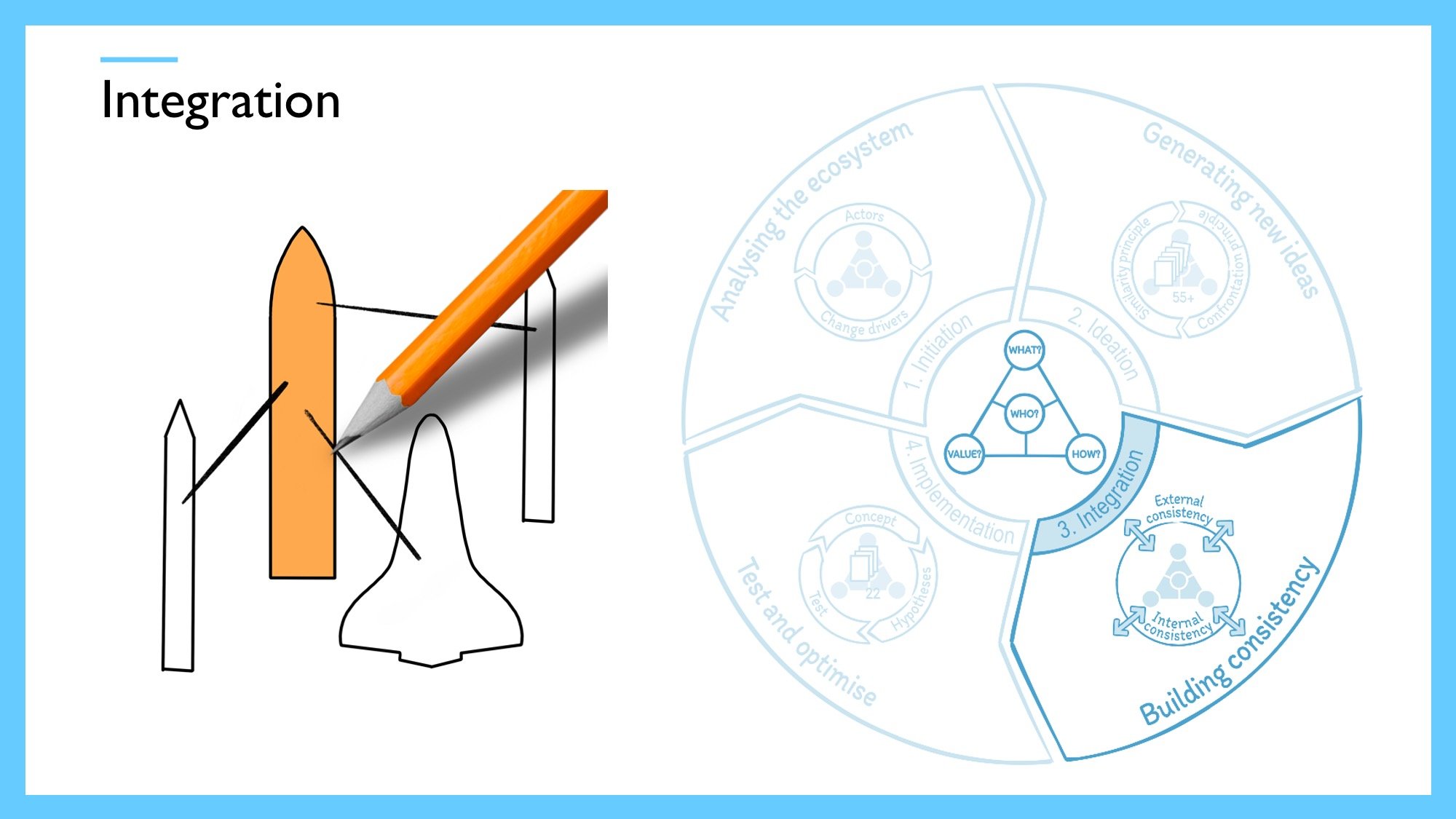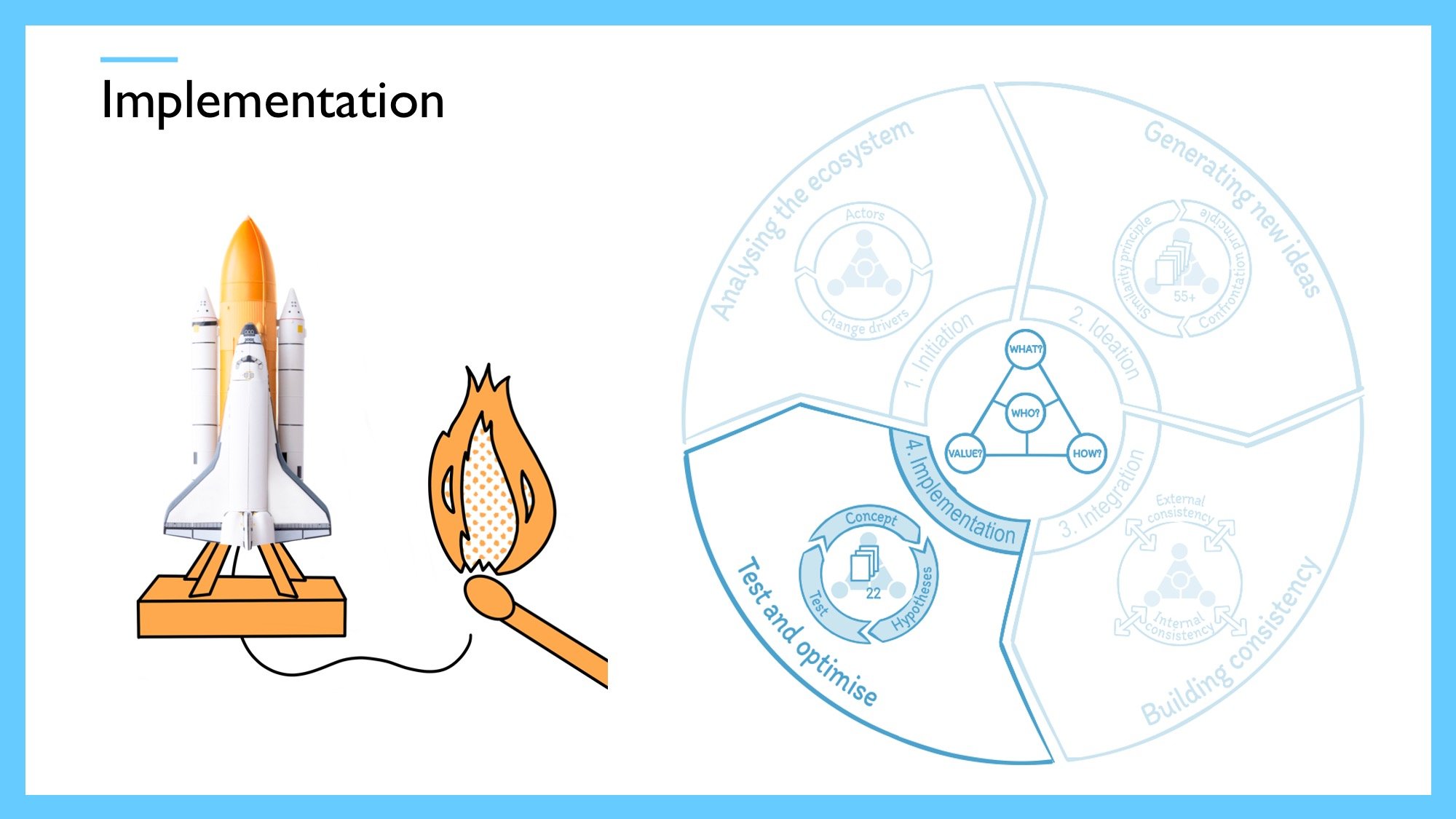Designing successful business models is a craft and not an art – with a suitable methodology, the right toolset and mindset business models can be innovated systematically. The methodology represents a crucial success factor in the process of business model innovation.
The following blog post briefly explains the business model navigator methodology developed at the University of St. Gallen by Professor Gassmann and his colleagues and successfully applied by various companies in the B2C and B2B market. In all companies, investments have been initiated as a result of the business model project, in some companies up to double-digit million amounts are invested.
Step 1: Initiation – preparing the journey
In the initiation phase, the ecosystem of the business model is analyzed holistically and with foresight. For this purpose, the current business model including the interaction with relevant actors is described. In addition, the environment is described in a "360-degree all-round view". For this the Ecosystem Map has proven to be a useful tool.
Making your own business model and industry logic transparent requires sufficient time and is quite complex. Therefore it should be carried out by a cross-departmental and cross-functional team. Furthermore, this exercise can create familiarity with thinking business models. Ideally, external people from outside the industry are also involved, because a business model innovation usually means a break with the prevailing industry- and company logic.
The ultimate aim of this phase is to develop an in-depth understanding of the current business model and the dynamics of its ecosystem environment.
Success factors
Involve open-minded team members from different functions; the involvement of industry outsiders supports thinking outside the box.
Overcome the dominant industry logic: Forbidden are sentences like ‘this has always worked like that in our industry’. Instead, a funeral speech for one´s own business helps to overcome the past. Why did the company die? This is a fascinating exercise, which McKinsey has often used successfully in change projects when individuals needed to overcome mental barriers.
Use methodological support, e.g., Ecosystem Map.
Step 2: Ideation – moving into new directions
In the ideation phase, the ideas for potential business model innovations are developed, typically in a workshop format. The results of the previous initiation phase often already indicate possible ideas for the new business model concepts. The spectrum of starting points for possible business model innovations is far-reaching - concrete customer problems, new technologies, or suspected potential benefits.
To enrich the ideation workshop with out-of-the-box ideas, the 55+ basic pattern cards can be a gamechanger. The cards display best practices patterns from other industries which can serve as inspiration for the ideation and help to break the dominant industry logic. You don’t have to “reinvent the wheel” each time you innovate your business model – research showed that 90% of all new business models have recombined already existing ideas, concepts, and technologies.
The way in which we apply the cards is termed “pattern confrontation” to describe the process of adapting the pattern to one’s own initial situation. The patterns can be adapted according to the “similarity principle” or the “confrontation principle”. According to the “similarity principle”, six to eight patterns that frequently can be observed in similar industries are identified and transferred to one's own business model. According to the “confrontation principle”, six to eight patterns that differ fundamentally from the basic logic of the own industry and which frequently can be observed in a completely different industry are identified and transferred to one's own business model.
Participants, typically divided into groups of three to five people, ask themselves how the pattern would change their business model if applied to their particular situation. At first glance the cards might seem unrelated to the problem, however, the results are quite surprising. In one instance, for example, the task of fitting the SUBSCRIPTION pattern to the business model of a machine manufacturer led to the idea of training sought-after plant operators and leasing them to customers. The concept was implemented and now contributes to the company’s turnover while at the same time strengthening ties with customers – which had been the original reason for thinking about a new business model. To structure and cluster the hopefully numerous ideas you generate during the workshop you can use our Opportunity Map.
Success Factors
Try not only the close patterns but also confront more distant patterns. We had surprising results when a 1st-tier automotive supplier applied the question: ‘How would McDonald´s conduct your business?’. For example, McDonald’s front desk employees are fully productive after a 30-minute introduction. The automotive supplier had to learn that reducing complexity would lead to totally new business models and would also stimulate quick learning.
Keep on trying. At first, it seems impossible to learn something from industry outsiders. Especially individuals with a profound background in the existing industry have difficulties in overcoming the dominant industry logic.
Step 3: Integration – completing the picture
There is no idea that is clear enough to be immediately implemented in a company. After a large number of possible concepts for business model innovation emerged in the ideation phase, these are integrated into one consistent business model.
The first step is to outline the idea in all four dimensions using the BMI Idea Sheet or a business model canvas. Once a business model concept is developed it is checked on its external- and internal consistency by identifying the underlying assumptions, understanding the business logic and the potential of the new business model to be profitable.
At this stage, do not overcomplicate this by creating a full-blown business case but rather use our Reverse Financials tool to quickly assess prices, market size and potential costs. Before spending too much time developing the business model concept further, gather your biggest assumptions regarding the customer and your value proposition and conduct qualitative interviews.
Use these valuable insights to check for the problem/solution fit of your idea and adjust the business model accordingly. Once you think you have a proposition that is valuable to customers that is also financially viable, start with the implementation.
Success factors
Don’t spend too much time on the details of your business model. Most of what you write down at this stage will change after the first reality check
Think in assumptions: most of what you gather is not yet proven in the market, so don’t act as if it is
Go to potential customers as soon as possible as their feedback can prevent you from spending a lot of money on a solution that nobody wants
Follow the feedback: use every feedback you get to change the course of your venture and don’t stick to your own ideas
Step 4: Implementation – realizing the new business model
The implementation of a new business model is always iterative. The cornerstone is to test the various dimensions of your business model gradually and step by step launch the new solution. Prototypes such as Minimum Viable Products (MVPs) and extensive testing are important to validate the assumptions and hypotheses behind the business model. In a nutshell, the testing iteration is based on: (1) the identification of the underlying assumptions ("we believe that..."), (2) the derrivement of falsifiable specific hypotheses (4) the choice of the test format – using our Testing Cards, (5) the development of the test procedure, (6) conduction of the test (feedback on hypotheses), (6) analysis and update of the business model concept.
Success factors
Think in the logic of affordable loss: decide on how much you are willing to spend in order to validate your assumptions rather than investing large sums in a business case that everyone in your company knows is wrong anyway
Decide on the organizational structure early: choose early in the testing phase whether you want to build the venture inside or outside the company, depending on the resources, the strategy and the culture of the company
Use Minimum Viable Products to get feedback for your solution in a quick and less expensive manner
Be resilient: after every success, there will be a setback. Building a new business model is messy and frustrating at times, don’t give up!
Learn more about the fundamentals of BMI. Read part 1 of our basics series.
Why does business model innovation matter? Get the answer in part 2 of our basics series.
We as the BMI Lab prepare companies for tomorrow by helping them to develop innovation strategies, design new business models, and build up internal innovation capabilities for long-term success. Do you need a sparring partner for your business model innovation journey? With our proven methodology, broad toolset, and comprehensive experience we will master the challenges together.
Author
Vera Konrad
Senior Innovation Consultant








